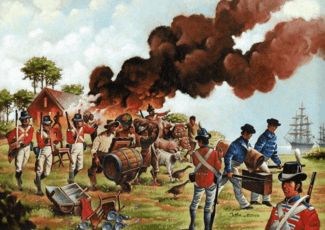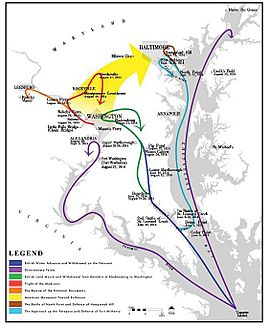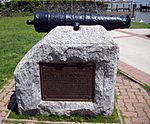Raid on Havre de Grace facts for kids
Quick facts for kids Raid on Havre de Grace |
|||||||
|---|---|---|---|---|---|---|---|
| Part of the War of 1812 | |||||||
 During the War of 1812, British naval forces attacked Havre de Grace, Maryland which showed resistance from the townspeople and Maryland Militia. After the British defeated them they raided the town at will until withdrawing back to their warships. |
|||||||
|
|||||||
| Belligerents | |||||||
Royal Navy |
|||||||
| Commanders and leaders | |||||||
| George Cockburn John Lawrence George Augustus Westphal |
John O'Neill | ||||||
| Strength | |||||||
| 150 Royal Marines Royal Regiment of Artillery Seamen |
Fewer than 40 Maryland Militiamen | ||||||
| Casualties and losses | |||||||
| 1 wounded | 1 dead | ||||||
The Raid on Havre de Grace was a quick military attack by sea. It happened on May 3, 1813, during the War of 1812. A group of British ships, led by Rear Admiral George Cockburn, attacked the town of Havre de Grace. This town is in Maryland, right where the Susquehanna River meets the Chesapeake Bay. Even though only one American person died, this raid made many Americans really dislike Cockburn.
Why the British Attacked Havre de Grace
Before attacking Havre de Grace, Admiral Cockburn had been sailing around the upper Chesapeake Bay. He had already taken over Spesutie Island on April 23, 1813.
A few days later, on April 29, he successfully raided a town called Frenchtown. After that, he tried to go further up the Elk River. However, soldiers at Fort Defiance stopped him.
Cockburn had made a promise: he would destroy any town that fought back against his forces. He didn't originally plan to attack Havre de Grace. But when he saw an American flag flying over the town and the local cannons fired at his ships, he decided to attack.
The Attack on the Town
Cockburn's ships were anchored near Turkey Point. Between his ships and Havre de Grace, the water was too shallow for big ships. So, Cockburn sent a group of 16 to 19 smaller boats. These boats, led by Commander John Lawrence, started rowing across the shallow water at midnight on May 3.
Even though people in Havre de Grace knew an attack might happen, most of the local militia (citizen soldiers) had left before the raid. Fewer than 40 militia members were left at the Concord Point battery when the British boats attacked at dawn. These few soldiers fired back for a short time. Then, a British Congreve rocket hit and killed a civilian.
After this, Lieutenant George Augustus Westphal and his troops quickly took over the battery.
Another brave American, Second Lieutenant John O'Neill, stayed behind. He single-handedly fired a cannon at another spot, sometimes called the "Potato Battery." But his cannon's powerful kick hit him. O'Neill then tried to fight the British with a musket (a type of rifle). He also tried to signal the other militia members to come back, but they didn't return.
As Westphal and his soldiers pushed forward, the townspeople and the remaining militia retreated. The British then raided the town. They burned 40 out of 60 houses. They did not burn the local Episcopal church, but they did damage it.
Cockburn took six cannons from the town. He also captured John O'Neill and two other Americans. He took them back to his main ship, the HMS Maidstone. However, local leaders asked Cockburn to release O'Neill, and he did. Cockburn reported that only one of his soldiers was hurt: Westphal was shot in the hand.
After raiding Havre de Grace, Cockburn sent his troops further up the Susquehanna River. They destroyed a supply area and some boats there. Other British forces went to Principio Furnace, which was a big factory that made iron and cannons. They destroyed that factory too.
How People Remembered the Raid
Many people wrote about the raid on Havre de Grace. Admiral Cockburn's own report was printed in a London newspaper called the London Gazette in July 1813.
Jared Sparks, who later became the president of Harvard University, was in Havre de Grace during the attack. He wrote about what he saw, and his story was published in a journal in 1817.
Another person who lived in Havre de Grace at the time, James Jones Wilmer, also wrote about the event soon after it happened.
Even though he wasn't there, Benjamin Henry Latrobe, a famous architect, wrote to his friend Robert Fulton about the raid.
The raid was also shown in a picture created by William Charles. He was an engraver (someone who makes pictures by carving them) from Scotland who moved to the United States. His picture, called Admiral Cockburn Burning & Plundering Havre de Grace, is now kept at the Maryland Historical Society.



